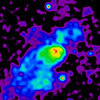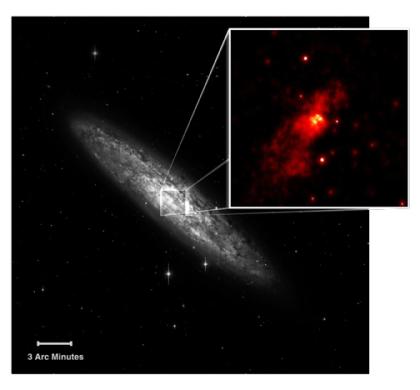Chandra Sees Wealth Of Black Holes In Star-Forming Galaxies
This Chandra X-ray image (inset) shows the central region of the starburst galaxy known as NGC 253 in comparison to the optical view. Chandra detects a proportionally high number of suspected intermediate-size black holes – a recently discovered class of objects. NGC 253 has at least six so-called ultraluminous (very powerful X-ray) point sources, and Chandra shows that four of them are located within about 3,000 light years from the galaxy's core. This relative close distance may imply that the ultraluminous objects -- which are usually found slightly farther out -- are gravitating towards the center of the galaxy.
NGC 253 is a starburst galaxy located some 8 million light years from Earth. Starburst galaxies are regions where stars form and explode at an unusually high rate. Chandra observed NGC 253 with the Advanced CCD Imaging Spectrometer (ACIS) instrument for 3.6 hours on December 16, 1999.
|
||||||||||||||||||||||||
NGC 253 is a spiral starburst galaxy located in the constellation Sculptor, about 13 million light-years away from Earth. The galaxy's X-ray emission is caused by high-energy processes such as supernova explosions and black hole accretion. In this image, the galaxy is shown in visible light and X-ray wavelengths. The visible light image reveals the entire galaxy and its characteristic spiral shape in black and white. The X-ray image pullout from the central area highlights its energetic features, and is shaped like a bright red-orange butterfly. Chandra detects a high number of suspected intermediate-size black holes – a recently discovered class of objects. NGC 253 has at least six so-called ultraluminous (very powerful X-ray) point sources, and Chandra shows that four of them are located within about 3,000 light years from the galaxy's core. This relative close distance may imply that the ultraluminous objects -- which are usually found slightly farther out -- are gravitating towards the center of the galaxy.





